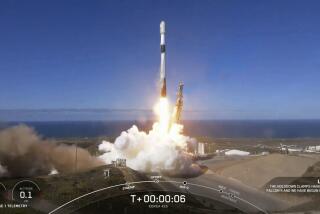Soviets Look to U.S. for Buyers of Space Data : Aerospace: The new Almaz-1 is the first Soviet satellite to provide services for customers in the United States under long-term contracts.
- Share via
WASHINGTON — The Soviet Union has launched a sophisticated Earth-watching satellite that Soviet officials hope will help open an American market for Soviet space services, the head of the Soviet space agency and a U.S. marketing firm announced Monday.
The 18.5-metric-ton Almaz-1 satellite, launched Sunday from a Soviet space base, will provide detailed optical and radar images of the Earth’s surface to commercial clients, including the U.S. government, according to officials of Houston-based Space Commerce Corp. The company is marketing data and images generated by the satellite to customers in the Western Hemisphere.
The Almaz-1 is the first Soviet satellite to provide commercial services for the American market under long-term contracts, William W. Wirin, executive vice president of Space Commerce, said at a press conference here. The satellite will travel in a polar orbit that will allow it to pass over all of the Earth’s surface once every three days or so.
Almaz-1 will compete with similar remote-sensing services provided by U.S. Eosat Inc., an American company that sells data from the Landsat satellites originally launched by the U.S. government, and SPOT Image, a French concern that sells remote-sensing data from French satellites.
However, Arthur M. Dula, president of Space Commerce, said he believes that the government agencies and private businesses that purchase images from Eosat and SPOT are likely to add Almaz images to their inventory rather than substitute them for those provided by the other companies.
Alexander Dunaev, chairman of Glavkosmos, the Soviet civil space agency, said the Almaz-1 originally was developed for military purposes but was converted for commercial use in the late 1980s. A prototype, Cosmos-1870, was launched in July, 1987.
Despite Dunaev’s assertion about its civil purposes, Aviation Week & Space Technology reported last fall that the Almaz-1 might yet have military applications. The aviation weekly reported that the Cosmos satellite can produce a radar image of the ocean floor to depths of hundreds of feet that conceivably could be used to track submarines.
However, Space Commerce officials said the satellite’s work is intended for U.S. agencies or private enterprises, including oil companies, that require detailed images of the Earth. The images generated can be used to evaluate agricultural lands and crops, study the geology of land and ocean surfaces, track oil slicks and the effects of acid rain and make topographic and other types of maps.
One of the principal customers for Almaz-1 images will be the U.S. Defense Mapping Agency, a unit of the Defense Department, Wirin said. The agency purchases Earth-imaging services for all branches of the U.S. government. Mapping agency officials were not available for comment Monday.
Dunaev said another purpose of his visit to the United States is to attempt to persuade American officials to lift the official ban on the launching of U.S. satellites on Soviet rockets. The effort so far has been unsuccessful.
The ban was put in place to halt the transfer of sophisticated satellite technology to the Soviet Union. At the same time, it responds to concerns voiced by American rocket makers, who argue that their commercial launches would be undercut by below-market rates offered by the Soviet Union.
That argument drew an angry reaction from Dula. “The next time an American company tells you they’re not subsidized, ask them who owns their tooling,” he said, referring to the U.S. government.
More to Read
Inside the business of entertainment
The Wide Shot brings you news, analysis and insights on everything from streaming wars to production — and what it all means for the future.
You may occasionally receive promotional content from the Los Angeles Times.










